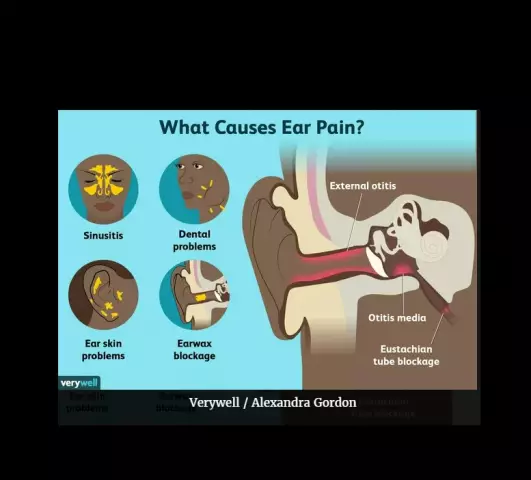- Author Rachel Wainwright [email protected].
- Public 2023-12-15 07:39.
- Last modified 2025-11-02 20:14.
Causes of pain in the bridge of the nose

The surest sign that the paranasal sinuses or the nasal cavity have undergone an inflammatory process are painful sensations in the nose bridge. It is necessary to consult a specialist as soon as possible in order to find out the causes of pain in the bridge of the nose and start timely treatment. This will help to avoid further exacerbation of the disease and its transition to a chronic form.
Why does the bridge of the nose hurt?
The upper part of the nose, adjacent to the forehead and forming a depression, is called the bridge of the nose. There are many reasons that can cause discomfort and discomfort in this area. Quite often, the bridge of the nose hurts in various injuries as a result of a violation of the integrity of tissues in case of bruises or fractures.
Other reasons that the bridge of the nose hurts:
- Nasal nerve neuralgia or Charlene's syndrome. This disease usually occurs in people under forty years of age as a result of sinus inflammation, various infections, deviated nasal septum, and even dental diseases. In this case, there are strong, bursting and pressing pains in the frontal part, in the area of the eye sockets and the bridge of the nose. The bridge of the nose especially hurts when pressed. They appear mainly at night and are paroxysmal in nature. Along with the pain, symptoms such as discharge of watery mucus from the eyes, swelling of the nasal mucosa, and redness of the eyes may occur. Against the background of this disease, in some cases, keratitis develops, in which there is a malnutrition of the cornea;
- Ganglionitis (ganglioneuritis) of the pterygopalatine node. It manifests itself as unexpected pain in the eyes, upper jaw, sometimes in the teeth and gums of the lower jaw. Often, unpleasant sensations can go to the temporal, occipital, cervical and shoulder regions. In many cases, the disease causes a kind of "vegetative storm" in which half of the face turns red and swells, there is lacrimation and a strong discharge of fluid from the nasal part of the numb. A similar attack, in which the bridge of the nose is especially sore, can last for several minutes, hours, or even a whole day. Basically, a person's condition worsens at night.
But most often, the cause of discomfort in the bridge of the nose is an inflammatory process that occurs in the nasal cavity or sinuses as a result of the accumulation of mucous secretions. In this case, pain can often radiate to the temples, back of the head, frontal part or eyes.
Why does the bridge of the nose hurt with a runny nose?
Inflammation of the nasal mucosa or rhinitis is a fairly common and seemingly harmless disease, but in reality it is not at all the case. The fact is that this area is closely connected with other organs and systems of the human body, inhaled and exhaled air passes through the nasal cavity. Therefore, even small violations of the physiological functions of the nose (respiratory, olfactory) can cause a negative reaction throughout the body.
Quite often, with rhinitis, patients experience a loss of appetite, and constant nasal discharge causes severe discomfort and causes bad habits. Usually, with a runny nose, the bridge of the nose hurts, a person cannot breathe normally through his nose, as a result, the work of blood vessels and the heart is disrupted, the respiratory organs suffer, and intracranial and intraocular pressure changes.
Also, a runny nose has a negative effect on lymph movement, blood circulation and brain function. Rhinitis can appear as a result of trauma, curvature of the nasal septum, acute respiratory viral infections, influenza, and with allergic reactions and improper treatment, it passes from an acute form to a chronic one.
Often, an untreated runny nose causes the development of sinusitis, a disease in which there is inflammation of one or more paranasal sinuses. At the same time, there is obstructed nasal breathing, mucous or purulent discharge, nasal congestion, the bridge of the nose hurts, and general weakness of the body is observed. Also, sinusitis is characterized by general symptoms of intoxication (fever, headaches).

Sometimes, against the background of colds or rhinitis, ethmoiditis or sinusitis develops. This is due to the fact that in acute inflammation of the paranasal sinuses, the lumen of the nasal cavity is significantly narrowed, so the discharge remains inside, thereby causing discomfort.
As a rule, when pressed, the bridge of the nose hurts much more intensely, and an increase in pain sensations causes pressure on the forehead and cheeks. Often, patients note with sinusitis the presence of unpleasant sensations in the frontal, parietal, occipital region. Restoring the normal outflow of nasal secretions helps to reduce pain. To do this, use local vasoconstrictor drugs (nasivin, galazolin).
If the bridge of the nose hurts, the first step is to treat the underlying disease. Preventive measures mainly consist in the elimination of acute and chronic inflammation of the upper respiratory tract, the resumption of nasal breathing with the help of conservative treatment, or, in extreme cases, surgery. An important role is also played by various restorative procedures, hardening of the body, which helps to increase its defenses.
YouTube video related to the article:
Found a mistake in the text? Select it and press Ctrl + Enter.






